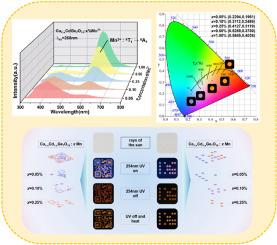Achieving multicolor luminescence via Mn2+ single doped in simple CaCdGe7O16 particles for multimode anti-counterfeiting
IF 5.6
2区 材料科学
Q1 MATERIALS SCIENCE, CERAMICS
引用次数: 0
Abstract
The multicolor and multimode luminescence material possess the advantages of multicolor, multimode luminescence, easy identification, so that it is widely concerned in the field of optical anti-counterfeiting and optical information storage. Therefore, it is makes sense of that this study use the doping of a single luminescent center to regulate the color of the luminescent color instead of simple mixing of different materials to achieve multicolor multimode luminescence. The as-prepared versatile CaCdGe7O16:Mn2+ luminescent microparticles prepared by high-temperature solid-phase method. The luminescent microparticles reveal the color from blue to orange-red under 254 nm UV light, while the 410 nm photoluminescence (PL) is attributed to the photoluminescence of CaCdGe7O16 (CCGO) host and 606 nm photoluminescence is attributed to the 4T1 - 6A1 transition of Mn2+. And revealing orange when 254 nm UV light is turned off or when 254 nm UV light is turned off and heated, along with the change of Mn2+ concentration (wavelength is 606 nm), due to the 4T1 - 6A1 transition of Mn2+. Under 254 nm UV light irradiation for 4 min, the afterglow time of the materials was 16000 s. Based on these superior properties, this study designs the dynamic multicolor and multimode luminescence Quick Response (QR) code pattern and a binary pattern, which offers the anti-counterfeiting technology toward a wide variety of applications to a certain extent.

在简单的CaCdGe7O16粒子中单掺杂Mn2+实现多色发光,用于多模防伪
多色多模发光材料具有多色、多模发光、易识别等优点,在光学防伪、光学信息存储等领域受到广泛关注。因此,本研究采用单一发光中心掺杂来调节发光颜色的颜色,而不是简单地混合不同材料来实现多色多模发光,是有意义的。高温固相法制备了多功能CaCdGe7O16:Mn2+发光微粒。发光微粒在254 nm紫外光照射下呈现蓝色至橙红色,其中410 nm的光致发光(PL)是CaCdGe7O16 (CCGO)宿主体的光致发光,606 nm的光致发光是Mn2+的4T1 - 6A1跃迁引起的。当关闭254 nm紫外光或关闭254 nm紫外光加热时,随着Mn2+浓度(波长为606 nm)的变化,由于Mn2+发生了4T1 - 6A1跃迁,呈现橙色。在254 nm紫外光照射4 min下,材料的余辉时间为16000 s。基于这些优越的特性,本研究设计了动态多色多模发光QR码图案和二进制图案,在一定程度上为防伪技术的广泛应用提供了可能。
本文章由计算机程序翻译,如有差异,请以英文原文为准。
求助全文
约1分钟内获得全文
求助全文
来源期刊

Ceramics International
工程技术-材料科学:硅酸盐
CiteScore
9.40
自引率
15.40%
发文量
4558
审稿时长
25 days
期刊介绍:
Ceramics International covers the science of advanced ceramic materials. The journal encourages contributions that demonstrate how an understanding of the basic chemical and physical phenomena may direct materials design and stimulate ideas for new or improved processing techniques, in order to obtain materials with desired structural features and properties.
Ceramics International covers oxide and non-oxide ceramics, functional glasses, glass ceramics, amorphous inorganic non-metallic materials (and their combinations with metal and organic materials), in the form of particulates, dense or porous bodies, thin/thick films and laminated, graded and composite structures. Process related topics such as ceramic-ceramic joints or joining ceramics with dissimilar materials, as well as surface finishing and conditioning are also covered. Besides traditional processing techniques, manufacturing routes of interest include innovative procedures benefiting from externally applied stresses, electromagnetic fields and energetic beams, as well as top-down and self-assembly nanotechnology approaches. In addition, the journal welcomes submissions on bio-inspired and bio-enabled materials designs, experimentally validated multi scale modelling and simulation for materials design, and the use of the most advanced chemical and physical characterization techniques of structure, properties and behaviour.
Technologically relevant low-dimensional systems are a particular focus of Ceramics International. These include 0, 1 and 2-D nanomaterials (also covering CNTs, graphene and related materials, and diamond-like carbons), their nanocomposites, as well as nano-hybrids and hierarchical multifunctional nanostructures that might integrate molecular, biological and electronic components.
 求助内容:
求助内容: 应助结果提醒方式:
应助结果提醒方式:


